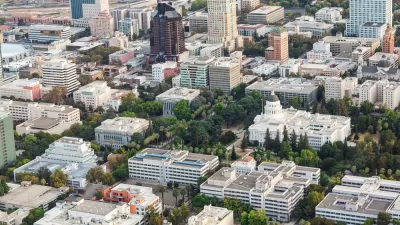Kathleen Pender, business columnist for the San Francisco Chronicle, points to two reasons why home prices rise amidst a Bay Area exodus to other states. On a state level, out-migration shows California's strong but dysfunctional economy.

"If you look just at domestic migration — people moving around the country — the Bay Area lost about 46,000 people more than it gained during the year that ended July 1, according to U.S. Census Bureau estimates released March 22 ," reports Pender on May 4. In other words, the region's net domestic migration was negative 46,000.
That net loss was nearly twice as big as the previous year and marked a turnaround from earlier years, when more people were coming to the Bay Area than leaving.
One thing these stories [in the national media hyping the Bay Area exodus based on Redfin report] mostly failed to mention is that net immigration — people coming from and leaving for other countries — is still positive in the Bay Area. About 58,000 more people came here from abroad than left last year, surpassing the nearly 46,000 who decamped for other states. (The census estimates included the nine-county Bay Area and three neighboring counties.*)
See Chronicle image [jpg] showing immigration and domestic migration graphs for the greater 12-county Bay Area.
===========================================================================================
California out-migration amidst economic growth – new report highlights dysfunction
While the Bay Area may have experienced net domestic in-migration until recently, the Golden State has endured net domestic out-migration for almost three decades, while continuing to grow modestly due largely to natural increase, i.e., births minus deaths, and to a lesser extent, net positive immigration, reaching 39,810,000 residents in 2017.
Courtesy California Legislative Analyst's Office.
County-level migration and immigration data is available from the Demographic Research Unit of the California Department of Finance's Dec. 27, 2017 report [pdf], posted here. Note that the last column, "Net Domestic Migration," on Figure E2, beginning on page 5, refers to both intrastate and interstate domestic migration, according to state demographer Phuong Nguyen.
According to a report released May 3 by San Francisco-based think tank Next 10, which looked at housing, migration and employment trends, the state "lost nearly 1.1 million more people to other states than it gained from 2006 to 2016," adds Pender.
It concluded that “the main driver for net out-migration appears to be high housing costs,” not high state income taxes. That’s because the “vast majority of people who moved out of California were concentrated in lower-skilled, lower-paying fields, namely sales, transportation and food preparation.”
“California has seen a net inflow of residents who earn more than $50,000 annually, have bachelor’s or advanced degrees, and work in high-skilled occupations. This is especially true for the Bay Area, where high salaries and abundant job opportunities outweigh the high cost of living,” the report said.
On May 4, the Associated Press reported that California edged-out the United Kingdom to claim the #5 stop in the world's strongest economies, after the U.S., China, Japan and Germany. "But a strong economy can also be dysfunctional, and not all Californians are benefitting," states the executive summary [pdf] of the report, prepared by Beacon Economics.
The state is experiencing shifting population dynamics driven by high housing costs and changes in the employment make-up of California residents.
MarketWatch also wrote about the Next 10 report on May 6: "With no letup in home prices, the California exodus surges."
Footnotes: *The Combined Statistical Area, or CSA, a U.S. Census term, for the 9-county Bay Area includes the three counties of San Joaquin, Santa Cruz, and San Benito that do not border San Francisco or San Pablo Bay, but are economically tied to the nine counties.
FULL STORY: If people are fleeing the Bay Area for cheaper housing, why is it still so costly?

Maui's Vacation Rental Debate Turns Ugly
Verbal attacks, misinformation campaigns and fistfights plague a high-stakes debate to convert thousands of vacation rentals into long-term housing.

Planetizen Federal Action Tracker
A weekly monitor of how Trump’s orders and actions are impacting planners and planning in America.

In Urban Planning, AI Prompting Could be the New Design Thinking
Creativity has long been key to great urban design. What if we see AI as our new creative partner?

King County Supportive Housing Program Offers Hope for Unhoused Residents
The county is taking a ‘Housing First’ approach that prioritizes getting people into housing, then offering wraparound supportive services.

Researchers Use AI to Get Clearer Picture of US Housing
Analysts are using artificial intelligence to supercharge their research by allowing them to comb through data faster. Though these AI tools can be error prone, they save time and housing researchers are optimistic about the future.

Making Shared Micromobility More Inclusive
Cities and shared mobility system operators can do more to include people with disabilities in planning and operations, per a new report.
Urban Design for Planners 1: Software Tools
This six-course series explores essential urban design concepts using open source software and equips planners with the tools they need to participate fully in the urban design process.
Planning for Universal Design
Learn the tools for implementing Universal Design in planning regulations.
planning NEXT
Appalachian Highlands Housing Partners
Mpact (founded as Rail~Volution)
City of Camden Redevelopment Agency
City of Astoria
City of Portland
City of Laramie






























